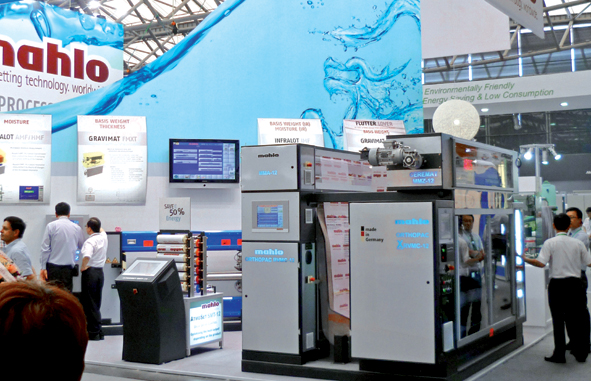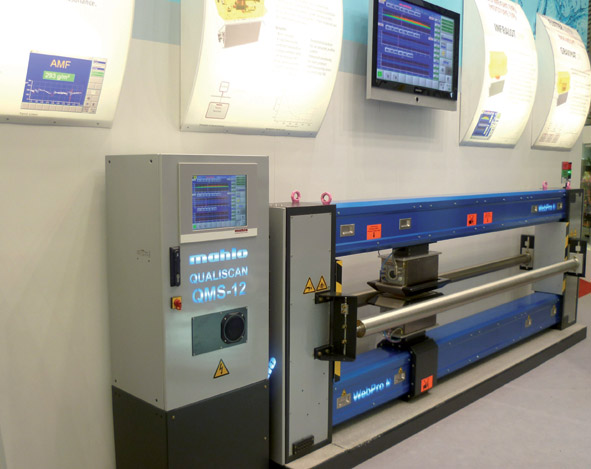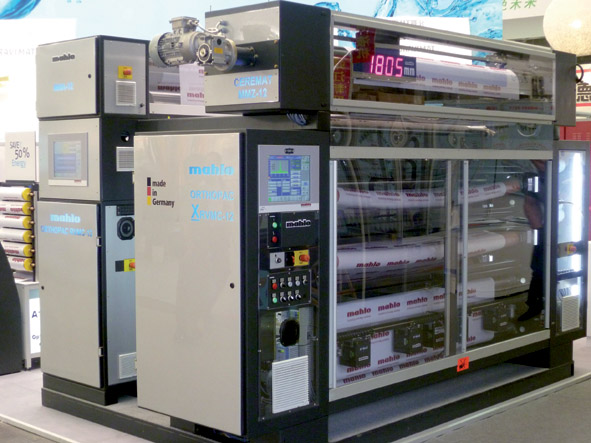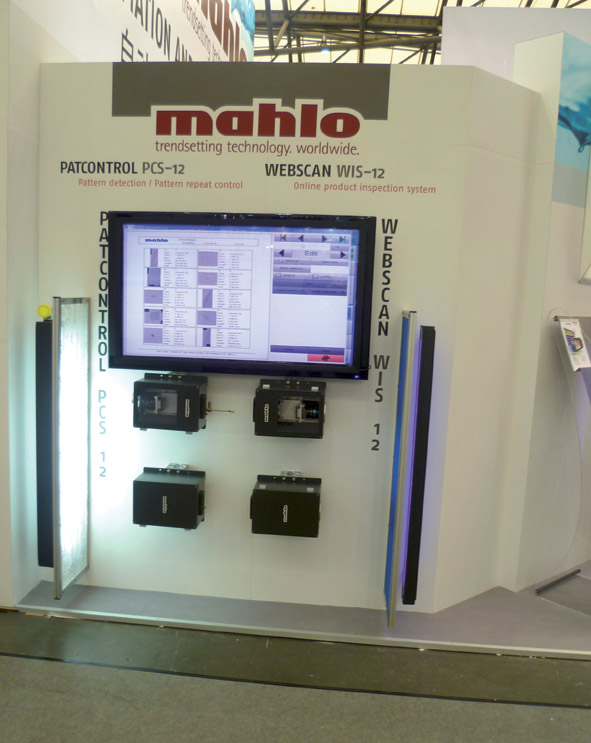 “Saving Costs – Conserving Resources” was the motto of Mahlo at ITMA Asia. In Shanghai the company once more emphasised its role as a global market leader of control systems for the textile industry without being limited to it.
“Saving Costs – Conserving Resources” was the motto of Mahlo at ITMA Asia. In Shanghai the company once more emphasised its role as a global market leader of control systems for the textile industry without being limited to it.
“We were surprised by the large number of visitors. Both the volume and the quality of the interested parties and customers exceeded our expectations,” said Rainer Mestermann, Managing Director of the company. The Mahlo team had its hands full managing to serve all interested parties at the exhibition.
 The uncluttered, open and generous booth architecture attracted the visitors. Of course, they were primarily interested in innovations and new products and, as usual, Mahlo had everything to offer.
The uncluttered, open and generous booth architecture attracted the visitors. Of course, they were primarily interested in innovations and new products and, as usual, Mahlo had everything to offer.
Amongst several products, a demonstration system with circulating product web was presented. Here the new straightening concept ORTHOPAC XRVMC-12 was displayed at its best. As the first and only straightening system it offers the advantageous combination of simultaneous feedforward and feedback control of the straightening process. The multiple straightening units, selectable independently from each other, guarantee optimal monitoring with even faster and more precise straightening results. “Right first time production” thus comes within close reach and contributes to lowered costs.
Patcontrol PCS-12, the camera-aided system, registers the lie of the pattern, monitors design repeat automatically, continuously measures the width of the material and realigns the pattern with the help of a straightening machine.
 Mahlo included the pin straightening wheel once more in the portfolio of straightening systems. The device exhibits some new and fresh ideas compared with known technology. For example, the counterforce produced by a spring always ensures the uniform and symmetric alignment of the pin wheels. Elaborate lever constructions requiring intensive maintenance can thus be dispensed with. An infinitely variable unclipping roller minimises residual bow and edge distortions.
Mahlo included the pin straightening wheel once more in the portfolio of straightening systems. The device exhibits some new and fresh ideas compared with known technology. For example, the counterforce produced by a spring always ensures the uniform and symmetric alignment of the pin wheels. Elaborate lever constructions requiring intensive maintenance can thus be dispensed with. An infinitely variable unclipping roller minimises residual bow and edge distortions.
The intelligent drive station with special voltage control for smallest product distortion activates or deactivates automatically (e.g., in case of blockages). A bypass function is available at the push of a button for products that cannot be straightened with the pin wheel. In addition, there is a version with combined roller straightening machine for customers who need to use both systems according to the articles.
 Webscan WIS-12, the automatic defect detection system, already successfully employed in the textile and nonwovens area, was presented with a wall installation in its revised and improved design. Especially the aspects of modularity and user-friendliness of the system were revised.
Webscan WIS-12, the automatic defect detection system, already successfully employed in the textile and nonwovens area, was presented with a wall installation in its revised and improved design. Especially the aspects of modularity and user-friendliness of the system were revised.
All components of the Webscan WIS-12 can now be scaled according to individual demand without exception. Operation and handling was significantly simplified, especially in the area of defect classification. Defect patterns now enable the operator to simply classify defects allowing similar defects to be found in the next pass.
Process control segment
The Atmoset SMT-12 from Mahlo facilitates product-dependent control of the heating capacity of cylinder dryers. With these dryers the heating capacity is usually optimised to the heaviest product. Because the web speed or the capacity cannot be simply adjusted for lighter products, the product is dried excessively and much energy is wasted.
Mahlo has found a means of controlling the capacity of the drier in a quick, simple and reliable manner through residual moisture measurement and feedback of the condensate temperature of the drying cylinders.
The Atmoset SMT enables a stable and effective drying process. The optimal degree of drying is always reached, regardless of the weight of the product or the web speed. Continuity of the production process and reproducibility of the product quality are ensured. The energy consumption of the dryers drops significantly due to the optimised heat output. This saves energy costs.
The development of sensors at Mahlo has not stagnated either. New sensors are employed either in the quality management system Qualiscan QMS-12 or in the stenter control system Optipac VMC-12.
X-ray transmission sensor Gravimat FMXT permits the contactless and traversing measurement of grammage/thickness of the running product webs over the entire product width. The properties of the material are determined precisely based on the X-ray absorption of the material. The X-ray tube without radioactive isotope emitter can be deactivated and does not require approval. It possesses superb resolution for precise profile control. High-quality components guarantee high measuring accuracy and service life.
The Infrascope NIR provides the spectral fingerprint of the product web. With a resolution of 256 measurements a complete spectrum is always scanned. This allows scanning the moisture, grammage, coating application and composition with a single sensor for suitable materials. So far the Infrascope can be employed in the nonwoven and plastic areas.
Air permeability measurement Airpro APM is a completely new sensor. This measuring head was developed in co-operation with the renowned Textest AG from Switzerland. Airpro APM allows for a highly dynamic and traversing measurement of air permeability and pressure drops on the running product web across the entire product width. Applications range from all types of surface structures, felts, dense paper and airbag fabric to extremely open nonwovens and paper sieves.
In the textile and clothing sector, air permeability is important for the exchange of air between the inner layers of clothing and the environment. This will substantially influence the wearing comfort of clothes. Air permeability is also important for drying after washing. In the technical sector, it plays a role in air and gas filters, or with air bags in the automobile industry.
Moisture measuring on microwave base
Aqualot AMF permits the exact determination of the total material moisture. The measurement is contactless and non-destructive. The ascertained moisture value can be supplied to a controller as actual value to regulate the web speed, dryer output or squeezing pressure.
The Aqualot AMF sends microwaves through the moist product web. The water in the product causes damping and phase shifting of the microwaves. The material moisture can be determined by comparing the output and input signals. The applications of the sensor include, amongst others, moisture measurement of textiles, nonwovens, paper and film or the application measurement of water-soluble coatings.